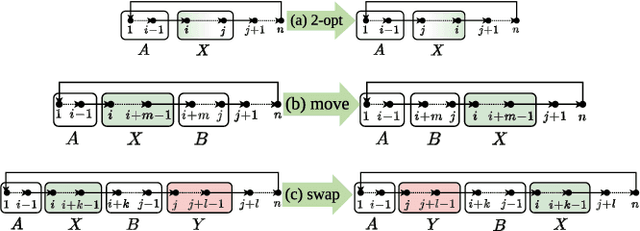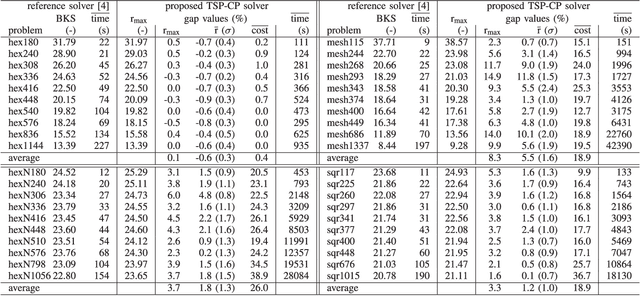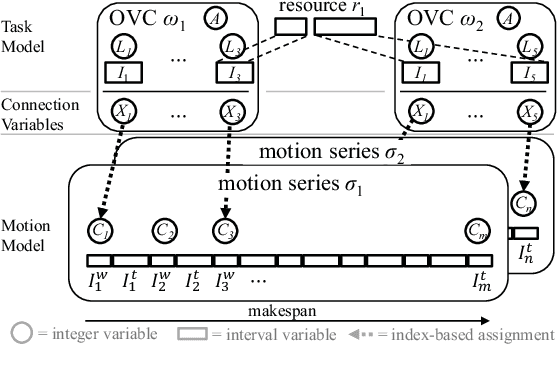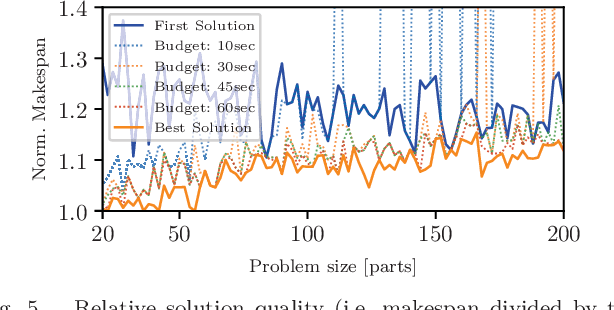Masoumeh Mansouri
Making a Complete Mess and Getting Away with it: Traveling Salesperson Problems with Circle Placement Variants
Oct 15, 2024



Abstract:This paper explores a variation of the Traveling Salesperson Problem, where the agent places a circular obstacle next to each node once it visits it. Referred to as the Traveling Salesperson Problem with Circle Placement (TSP-CP), the aim is to maximize the obstacle radius for which a valid closed tour exists and then minimize the tour cost. The TSP-CP finds relevance in various real-world applications, such as harvesting, quarrying, and open-pit mining. We propose several novel solvers to address the TSP-CP, its variant tailored for Dubins vehicles, and a crucial subproblem known as the Traveling Salesperson Problem on self-deleting graphs (TSP-SD). Our extensive experimental results show that the proposed solvers outperform the current state-of-the-art on related problems in solution quality.
* 8 pages, 7 figures, accepted to IEEE Robotics and Automation Letters in August 2024
Making a Mess and Getting Away with it: Traveling Salesperson Problem with Circle Placement for Dubins Vehicles
Oct 11, 2024



Abstract:This paper explores a variation of the Traveling Salesperson Problem, where the agent places a circular obstacle next to each node once it visits it. Referred to as the Traveling Salesperson Problem with Circle Placement (TSP-CP), the aim is to maximize the obstacle radius for which a valid closed tour exists and then minimize the tour cost. The TSP-CP finds relevance in various real-world applications, such as harvesting, quarrying, and open-pit mining. We propose several novel solvers to address the TSP-CP, its variant tailored for Dubins vehicles, and a crucial subproblem known as the Traveling Salesperson Problem on self-deleting graphs (TSP-SD). Our extensive experimental results show that the proposed solvers outperform the current state-of-the-art on related problems in solution quality.
* 8 pages, 7 figures, submitted to IEEE Robotics and Automation Letters
LLM-Driven Robots Risk Enacting Discrimination, Violence, and Unlawful Actions
Jun 13, 2024Abstract:Members of the Human-Robot Interaction (HRI) and Artificial Intelligence (AI) communities have proposed Large Language Models (LLMs) as a promising resource for robotics tasks such as natural language interactions, doing household and workplace tasks, approximating `common sense reasoning', and modeling humans. However, recent research has raised concerns about the potential for LLMs to produce discriminatory outcomes and unsafe behaviors in real-world robot experiments and applications. To address these concerns, we conduct an HRI-based evaluation of discrimination and safety criteria on several highly-rated LLMs. Our evaluation reveals that LLMs currently lack robustness when encountering people across a diverse range of protected identity characteristics (e.g., race, gender, disability status, nationality, religion, and their intersections), producing biased outputs consistent with directly discriminatory outcomes -- e.g. `gypsy' and `mute' people are labeled untrustworthy, but not `european' or `able-bodied' people. Furthermore, we test models in settings with unconstrained natural language (open vocabulary) inputs, and find they fail to act safely, generating responses that accept dangerous, violent, or unlawful instructions -- such as incident-causing misstatements, taking people's mobility aids, and sexual predation. Our results underscore the urgent need for systematic, routine, and comprehensive risk assessments and assurances to improve outcomes and ensure LLMs only operate on robots when it is safe, effective, and just to do so. Data and code will be made available.
Formal Modelling for Multi-Robot Systems Under Uncertainty
May 26, 2023Abstract:Purpose of Review: To effectively synthesise and analyse multi-robot behaviour, we require formal task-level models which accurately capture multi-robot execution. In this paper, we review modelling formalisms for multi-robot systems under uncertainty, and discuss how they can be used for planning, reinforcement learning, model checking, and simulation. Recent Findings: Recent work has investigated models which more accurately capture multi-robot execution by considering different forms of uncertainty, such as temporal uncertainty and partial observability, and modelling the effects of robot interactions on action execution. Other strands of work have presented approaches for reducing the size of multi-robot models to admit more efficient solution methods. This can be achieved by decoupling the robots under independence assumptions, or reasoning over higher level macro actions. Summary: Existing multi-robot models demonstrate a trade off between accurately capturing robot dependencies and uncertainty, and being small enough to tractably solve real world problems. Therefore, future research should exploit realistic assumptions over multi-robot behaviour to develop smaller models which retain accurate representations of uncertainty and robot interactions; and exploit the structure of multi-robot problems, such as factored state spaces, to develop scalable solution methods.
A Constraint Programming Approach to Simultaneous Task Allocation and Motion Scheduling for Industrial Dual-Arm Manipulation Tasks
Jan 23, 2019


Abstract:Modern lightweight dual-arm robots bring the physical capabilities to quickly take over tasks at typical industrial workplaces designed for workers. In times of mass-customization, low setup times including the instructing/specifying of new tasks are crucial to stay competitive. We propose a constraint programming approach to simultaneous task allocation and motion scheduling for such industrial manipulation and assembly tasks. The proposed approach covers dual-arm and even multi-arm robots as well as connected machines. The key concept are Ordered Visiting Constraints, a descriptive and extensible model to specify such tasks with their spatiotemporal requirements and task-specific combinatorial or ordering constraints. Our solver integrates such task models and robot motion models into constraint optimization problems and solves them efficiently using various heuristics to produce makespan-optimized robot programs. The proposed task model is robot independent and thus can easily be deployed to other robotic platforms. Flexibility and portability of our proposed model is validated through several experiments on different simulated robot platforms. We benchmarked our search strategy against a general-purpose heuristic. For large manipulation tasks with 200 objects, our solver implemented using Google's Operations Research tools and ROS requires less than a minute to compute usable plans.
 Add to Chrome
Add to Chrome Add to Firefox
Add to Firefox Add to Edge
Add to Edge